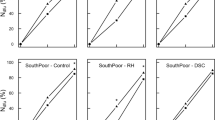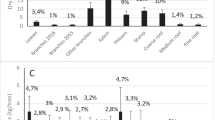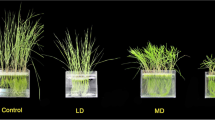Abstract
Aims
Belowground carbon transfer from plant to plant has been extensively described, but such transfer for nitrogen has been less thoroughly investigated when the donor is a non-N2-fixing species. This study, applied to forest regeneration, aimed to determine whether tree seedlings facilitated neighbouring grass growth through nitrogen transfer at an early stage of development, thus facilitating nitrogen acquisition by understory species.
Methods
Quercus petraea seedlings were planted in pots either sole-grown or mixed-grown with Molinia caerulea tufts or another oak seedling. 15N-urea pulse-chase labelling (cotton wick method) was performed in oak shoots and the fate of 15N in each soil and plant compartment was tracked for one year. N transfer pathways were investigated using two degrees of physical separation between root systems.
Results
Molinia dry weight was higher when mixed-grown with oak seedlings than when sole-grown. Increase in grass dry weight correlated with N transfer from donor oak to receiver Molinia. Interestingly, the presence of Molinia increased N rhizodeposition of oak. N allocation in donor oak towards root in winter and shoot in spring was enhanced.
Conclusions
Oak seedlings facilitated Molinia growth through rapid N transfer, underlining the ability of non-N2-fixing species to supply N to neighbours. 15N allocation within donor oak and its rhizodeposition depended on neighbour identity.





Similar content being viewed by others

Change history
30 April 2020
In the published version of this paper, the titles for figures 3 and 4 should be presented as below:
Abbreviations
- SG:
-
Sole-grown
- Mesh1:
-
1 μm Mesh
- Mesh30:
-
30 μm Mesh
- MG:
-
Mixed-grown
References
Balandier P, Collet C, Miller JH et al (2006) Designing forest vegetation management strategies based on the mechanisms and dynamics of crop tree competition by neighbouring vegetation. Forestry 79:3–27. https://doi.org/10.1093/forestry/cpi056
Bausenwein U, Millard P, Thornton B, Raven JA (2001) Seasonal nitrogen storage and remobilization in the forb Rumex acetosa. Funct Ecol 15:370–377. https://doi.org/10.1046/j.1365-2435.2001.00524.x
Bazot S, Fresneau C, Damesin C, Barthes L (2016) Contribution of previous year’s leaf N and soil N uptake to current year’s leaf growth in sessile oak. Biogeosciences 13:3475–3484. https://doi.org/10.5194/bg-13-3475-2016
Bertness MD, Callaway RM (1994) Positive interactions in communities. Tree 9:191–193. https://doi.org/10.1201/9780203738559
Bethlenfalvay GJ, Reyes-Solis MG, Camel SB, Ferrera-Cerrato R (1991) Nutrient transfer between the root zones of soybean and maize plants connected by a common mycorrhizal mycelium. Physiol Plant 82:423–432. https://doi.org/10.1034/j.1399-3054.1991.820315.x
Bhatt MV, Khandelwal A, Dudley SA (2011) Kin recognition, not competitive interactions, predicts root allocation in young Cakile edentula seedling pairs. New Phytol 189:1135–1142. https://doi.org/10.1111/j.1469-8137.2010.03548.x
Bleasdale JKA (1960) Studies on plant competition. In: Harper JL (ed) Biology of weeds. Oxford, England, Blackwell Science Pub, pp 133–142
Boulter D, Jeremy JJ, Wilding M (1966) Amino acids liberated into the culture medium by pea seedling roots. Plant Soil 24:121–127. https://doi.org/10.1007/BF01373078
Bowsher AW, Evans S, Tiemann LK, Friesen ML (2018) Effects of soil nitrogen availability on rhizodeposition in plants: a review. Plant Soil 423:59–85. https://doi.org/10.1007/s11104-017-3497-1
Bronstein JL (2009) The evolution of facilitation and mutualism. J Ecol 97:1160–1170. https://doi.org/10.1111/j.1365-2745.2009.01566.x
Bruno JF, Stachowicz JJ, Bertness MD (2003) Inclusion of facilitation into ecological theory. Trends Ecol Evol 18:119–125. https://doi.org/10.1016/S0169-5347(02)00045-9
Callaway RM (1995) Positive interactions among plants. Bot Rev 61:306–349. https://doi.org/10.1007/BF02912621
Canarini A, Kaiser C, Merchant A et al (2019) Corrigendum: root exudation of primary metabolites: mechanisms and their roles in plant responses to environmental stimuli. Front Plant Sci 10:1–19. https://doi.org/10.3389/fpls.2019.00420
Chen J, Wu F, Liu T et al (2012) Emissions of nitric oxide from 79 plant species in response to simulated nitrogen deposition. Environ Pollut 160:192–200. https://doi.org/10.1016/j.envpol.2011.09.007
Clements FE, Hanson HC, Weaver JE (1929) Plant competition; an analysis of community functions. 340 pp
Coll L, Balandier P, Picon-Cochard C (2004) Morphological and physiological responses of beech (Fagus sylvatica) seedlings to grass-induced belowground competition. Tree Physiol 24:45–54
Craine JM (2005) Reconciling plant strategy theories of Grime and Tilman. J Ecol 93:1041–1052. https://doi.org/10.1111/j.1365-2745.2005.01043.x
Craine JM, Dybzinski R (2013) Mechanisms of plant competition for nutrients, water and light. Funct Ecol 27:833–840. https://doi.org/10.1111/1365-2435.12081
de Graaff M-A, Six J, van Kessel C (2007) Elevated CO2 increases nitrogen rhizodeposition and microbial immobilization of root-derived nitrogen. New Phytol 173:778–786. https://doi.org/10.1111/j.1469-8137.2006.01974.x
Dhamala N, Rasmussen J, Carlsson G et al (2016) N transfer in three-species grass-clover mixtures with chicory, ribwort plantain or caraway. Plant Soil 413:1–14. https://doi.org/10.1007/s11104-016-3088-6
Dickie IA (2001) Vesicular-arbuscular mycorrhizal infection of Quercus rubra seedlings. New Physiol 151:257–264. https://doi.org/10.1046/j.1469-8137.2001.00148.x
Eilers G, Brurnrnc R, Matznep E (1992) Above-ground N-uptake from wet deposition by Norway spruce (Picea abies Karst.). For Ecol Manage 51:239–247. https://doi.org/10.1016/0378-1127(92)90489-V
Eissenstat DM (1990) A comparison of phosphorus and nitrogen transfer between plants of different phosphorus status. Oecologia 82:342–347. https://doi.org/10.1007/BF00317481
Ek H, Anderson S, Söderström B (1996) Carbon and nitrogen flow in silver birch and Norway spruce connected by a common mycorrhizal mycelium. Mycorrhiza 6:465–467
Epstein E (1961) The essential role of calcium in selective cation transport by plant cells. Plant Physiol 36:437–444. https://doi.org/10.1104/pp.36.4.437
Fehsenfeld F, Calvert J, Fall R et al (1992) Emissions of volatile organic compounds from vegetation and the implications for atmospheric chemistry. Global Biogeochem Cycles 6:389–430. https://doi.org/10.1029/92GB02125
Feng W, Guo B, Zhang H et al (2015) Remote estimation of above ground nitrogen uptake during vegetative growth in winter wheat using hyperspectral red-edge ratio data. F Crop Res 180:197–206. https://doi.org/10.1016/j.fcr.2015.05.020
Fernandez C, Monnier Y, Santonja M et al (2016) The impact of competition and allelopathy on the trade-off between plant defense and growth in two contrasting tree species. Front Plant Sci 7:1–14. https://doi.org/10.3389/fpls.2016.00594
Frey B, Schüepp H (1993) A role of vesicular-arbuscular (VA) mycorrhizal fungi in facilitating interplant nitrogen transfer. Soil Biol Biochem 25:651–658. https://doi.org/10.1016/0038-0717(93)90104-J
Friedrich JM, Dawson J (1984) Soil nitrogen concentration and Juglans nigra growth in mixed plots with nitrogen-fixing Alnus, Elaeagnus, Lespedeza and Robinia species. Can J For Res 14:864–868
Fustec J, Lesuffleur F, Mahieu S, Cliquet J (2010) Nitrogen rhizodeposition of legumes. A review. Agron Sustain Dev 30:57–66. https://doi.org/10.1051/agro/2009003
Gargaglione V, Peri PL, Rubio G (2014) Tree-grass interactions for N in Nothofagus antarctica silvopastoral systems: Evidence of facilitation from trees to underneath grasses. Agrofor Syst 88:779–790. https://doi.org/10.1007/s10457-014-9724-3
Gorka S, Dietrich M, Mayerhofer W et al (2019) Rapid transfer of plant photosynthates to soil bacteria via ectomycorrhizal hyphae and its interaction with nitrogen availability. Front Microbiol 10:1–20. https://doi.org/10.3389/FMICB.2019.00168
Govindarajulu M, Pfeffer PE, Jin H et al (2005) Nitrogen transfer in the arbuscular mycorrhizal symbiosis. Nature 435:819–823. https://doi.org/10.1038/nature03610
Grime JP (1974) Vegetation classification by reference to strategies. Nature 250:26–31. https://doi.org/10.1038/252497a0
Grove S, Haubensak KA, Parker IM (2013) Direct and indirect effects of allelopathy in the soil legacy of an exotic plant invasion. Plant Ecol 213:1869–1882. https://doi.org/10.1007/s11258-012-0079-4
Guenther A, Nicholas Hewitt C, David E et al (1995) A global model of natural volatile organic compound emissions. J Geophys Res 100:8873–8892. https://doi.org/10.1029/94JD02950
Guo B, Qi S, Heng Y et al (2017) Remotely assessing leaf N uptake in winter wheat based on canopy hyperspectral red-edge absorption. Eur J Agron 82:113–124. https://doi.org/10.1016/j.eja.2016.10.009
Hale MG, Foy C, Shay FJ (1971) Factors affecting root exudation. Adv Agron 23:89–109. https://doi.org/10.1016/S0065-2113(08)60151-0
Hayatsu M, Tago K, Saito M (2008) Various players in the nitrogen cycle: diversity and functions of the microorganisms involved in nitrification and denitrification. Soil Sci Plant Nutr 54:33–45. https://doi.org/10.1111/j.1747-0765.2007.00195.x
Haystead A, Marriott C (1978) Fixation and transfer of nitrogen in a white clover-grass sward under hill conditions. Proc Assoc Appl Biol 3:453–457. https://doi.org/10.1111/j.1744-7348.1978.tb00740.x
Haystead A, Marriott C (1979) Transfer of legume nitrogen to associated grass. Soil Biol Biochem 11:99–104. https://doi.org/10.1016/0038-0717(79)90083-X
Haystead A, Malajczuk N, Grove TS (1988) Underground transfer of nitrogen between pasture plants infected with vesicular-arbuscular mycorrhizal fungi. New Phytol 108:417–423. https://doi.org/10.1111/j.1469-8137.1988.tb04182.x
He X-H, Critchley C, Bledsoe C (2003) Nitrogen transfer within and between plants through common mycorrhizal networks (CMNs). CRC Crit Rev Plant Sci 22:531–567. https://doi.org/10.1080/713608315
He X, Bledsoe CS, Zasoski RJ et al (2006) Rapid nitrogen transfer from ectomycorrhizal pines to adjacent ectomycorrhizal and arbuscular mycorrhizal plants in a California oak woodland. New Phytol 170:143–151. https://doi.org/10.1111/j.1469-8137.2006.01648.x
He X, Xu M, Qiu GY, Zhou J (2009) Use of 15N stable isotope to quantify nitrogen transfer between mycorrhizal plants. J Plant Ecol 2:107–118. https://doi.org/10.1093/jpe/rtp015
He Y, Cornelissen JHC, Wang P et al (2019) Nitrogen transfer from one plant to another depends on plant biomass production between conspecific and heterospecific species via a common arbuscular mycorrhizal network. Environ Sci Pollut Res 26:8828–8837. https://doi.org/10.1007/s11356-019-04385-x
Henzell EF, Martin AE, Ross PJ, Haydock KP (1964) Isotopic studies on the uptake of sulphur by pasture plants. Aust J Agric Res 15:876–884. https://doi.org/10.1080/00288233.1977.10427327
Holzinger R, Sandoval-Soto L, Rottenberger S et al (2000) Emissions of volatile organic compounds from Quercus ilex L. measured by proton transfer reaction mass spectrometry under different environmental conditions. J Geophys Res Atmos 105:573–579. https://doi.org/10.1029/2000jd900296
Hong J, Ma X, Zhang X, Wang X (2017) Nitrogen uptake pattern of herbaceous plants: coping strategies in altered neighbor species. Biol Fertil Soils 53:729–735. https://doi.org/10.1007/s00374-017-1230-0
Huang W, Gfeller V, Erb M (2019) Root volatiles in plant-plant interactions II: Root volatiles alter root chemistry and plant-herbivore interactions of neighboring plants. Plant Cell Environ 42:1946–1973. https://doi.org/10.1101/441790
Hunter AF, Aarssen LW (1988) Plants helping plants: new evidence indicates that beneficence is important in vegetation. Am Inst Biol Sci 38:34–40. https://doi.org/10.2307/1310644
Jalonen R, Nygren P, Sierra J (2009) Transfer of nitrogen from a tropical legume tree to an associated fodder grass via root exudation and common mycelial networks. Plant, Cell Environ 32:1366–1376. https://doi.org/10.1111/j.1365-3040.2009.02004.x
Jensen ES (1996) Rhizodeposition of N by pea and barley and its effect on soil N dynamics. Soil Biol Biochem 28:65–71. https://doi.org/10.1016/0038-0717(95)00116-6
Johansen A, Jensen ES (1996) Transfer of N and P from intact or decomposing roots of pea to barley interconnected by an arbuscular mycorrhizal fungus. Soil Biol Biochem 28:73–81. https://doi.org/10.1016/0038-0717(95)00117-4
Kaitaniemi P, Lintunen A, Sievänen R, Perttunen J (2018) Computational analysis of the effects of light gradients and neighbouring species on foliar nitrogen. Ecol Inform 48:171–177. https://doi.org/10.1016/j.ecoinf.2018.09.009
Khan WDF, Peoples MB, Herridge DF (2002) Quantifying below-ground nitrogen of legumes. Plant Soil 245:327–334. https://doi.org/10.1023/A:1020407006212
Klein T (2016) Belowground carbon trade among talltrees in a temperate forest. Science (80- ) 352:342–344. https://doi.org/10.6084/m9.figshare.3081127
Kohli RK, Batish D, Singh HP (1998) Allelopathy and its implications in agroecosystems. J Crop Prod 1:169–202. https://doi.org/10.1300/j144v01n01_08
Kong C-H, Zhang S-Z, Li Y-H et al (2018) Plant neighbor detection and allelochemical response are driven by root-secreted signaling chemicals. Nat Commun 9:1–9. https://doi.org/10.1038/s41467-018-06429-1
Li X, Rennenberg H, Simon J (2015) Competition for nitrogen between Fagus sylvatica and Acer pseudoplatanus seedlings depends on soil nitrogen availability. Front Plant Sci 6:1–11. https://doi.org/10.3389/fpls.2015.00302
Mahieu S, Fustec J, Faure ML et al (2007) Comparison of two 15N labelling methods for assessing nitrogen rhizodeposition of pea. Plant Soil 295:193–205. https://doi.org/10.1007/s11104-007-9275-8
Mahieu S, Fustec J, Jensen ES, Crozat Y (2009) Does labelling frequency affect N rhizodeposition assessment using the cotton-wick method? Soil Biol Biochem 41:2236–2243. https://doi.org/10.1016/j.soilbio.2009.08.008
Mallik A (1998) Allelopathy and competition in coniferous forests. Environ For Sci 54:309–315. https://doi.org/10.1007/978-94-011-5324-9_33
Millard P (1994) Measurement of the remobilization of nitrogen for spring leaf growth of trees under field conditions. Tree Physiol 14:1049–1054. https://doi.org/10.1093/treephys/14.7-8-9.1049
Millard P, Gwen.-Aelle G (2010) Nitrogen storage and remobilization by trees : ecophysiological relevance in a changing world. Tree Physiol 30:1083–1095
Molisch H (1937) Der Einfluss einer pflanze auf die andere, allelopathie. Nature 141:493
Mommer L, Kirkegaard J, van Ruijven J (2016) Root–root interactions: towards a rhizosphere framework. Trends Plant Sci 21:209–217. https://doi.org/10.1016/j.tplants.2016.01.009
Montesinos-Navarro A, Verdú M, Querejeta JI, Valiente-Banuet A (2017) Nurse plants transfer more nitrogen to distantly related species. Ecology 98:1300–1310. https://doi.org/10.1002/ecy.1771
Moyer-Henry KA, Burton JW, Israel DW, Rufty TW (2006) Nitrogen transfer between plants: A 15N natural abundance study with crop and weed species. Plant Soil 282:7–20
Muller CH (1969) Allelopathy as a factor in ecological process. Vegetatio 18:348–357. https://doi.org/10.1007/BF00332847
Neilsen D, Millard P, Herbert LC et al (2000) Remobilization and uptake of N by newly planted apple (Malus domestica) trees in response to irrigation method and timing of N application. Tree Physiol 21:513–521. https://doi.org/10.1093/treephys/21.8.513
Paterson E, Gebbing T, Abel C et al (2006) Rhizodeposition shapes rhizosphere microbial community structure in organic soil. New Phytol 173:600–610. https://doi.org/10.1111/j.1469-8137.2006.01931.x
Philipps DA, Fox TC, Six J (2006) Root exudation (net efflux of amino acids) may increase rhizodeposition under elevated CO2. Glob Chang Biol 12:561–567. https://doi.org/10.1111/j.1365-2486.2006.01100.x
Pierik R, Mommer L, Voesenek LA (2013) Molecular mechanisms of plant competition: neighbour detection and response strategies. Funct Ecol 27:841–853. https://doi.org/10.1111/1365-2435.12010
Rasmann S, Turlings TCJ (2016) Root signals that mediate mutualistic interactions in the rhizosphere. Curr Opin Plant Biol 32:62–68. https://doi.org/10.1016/j.pbi.2016.06.017
Ribeiro Paula R, Bouillet JP, Ocheuze Trivelin PC et al (2015) Evidence of short-term belowground transfer of nitrogen from Acacia mangium to Eucalyptus grandis trees in a tropical planted forest. Soil Biol Biochem 91:99–108. https://doi.org/10.1016/j.soilbio.2015.08.017
Rice EL (1985) Chemically mediated interactions between plants and other organisms. Chem Mediat Interact between Plants Other Org 19:81–105. https://doi.org/10.1007/978-1-4757-9658-2
Robertson GP, Groffman PM (2007) Nitrogen transformations. In: Soil microbiology, ecology and biochemistry, Third Edit. Elsevier Inc., pp 341–364
Rovira AD (1969) Plant root exudates. Bot Rev 35:35–57. https://doi.org/10.1007/BF02859887
San Emeterio L, Damgaard C, Canals RM (2007) Modelling the combined effect of chemical interference and resource competition on the individual growth of two herbaceous populations. Plant Soil 292:95–103. https://doi.org/10.1007/s11104-007-9205-9
Scandellari F, Ventura M, Gioacchini P et al (2010) Seasonal pattern of net nitrogen rhizodeposition from peach (Prunus persica (L.) Batsch) trees in soils with different textures. Agric Ecosyst Environ 136:162–168. https://doi.org/10.1016/j.agee.2009.12.017
Schenck Zu Schweinsberg-Mickan M, Jörgensen RG, Müller T (2012) Rhizodeposition: its contribution to microbial growth and carbon and nitrogen turnover within the rhizosphere. J Plant Nutr Soil Sci 175:750–760. https://doi.org/10.1002/jpln.201100300
Schöb C, Prieto I, Armas C, Pugnaire FI (2014) Consequences of facilitation: one plant’s benefit is another plant’s cost. Funct Ecol 28:500–508. https://doi.org/10.1111/1365-2435.12185
Schreiner O, Reed HS (1907) The production of deleterious excretions by roots. Bull Torrey Bot Club 34:279–303. https://doi.org/10.2307/2479157
Semchenko M, Saar S, Lepik A (2014) Plant root exudates mediate neighbour recognition and trigger complex behavioural changes. New Phytol 204:631–637. https://doi.org/10.1111/nph.12930
Shamoot S, McDonald L, Bartholomew WV (1968) Rhizo-deposition of organic debris in soil. Soil Sci Soc Am Proc 32:817–820. https://doi.org/10.2136/sssaj1968.03615995003200060031x
Simard SW, Perry DA (1997) Net transfer of carbon between ectomycorrhizal tree species in the field. Nature 388:579. https://doi.org/10.1038/41557
Simard SW, Durall DM, Jones MD (1997a) Carbon allocation and carbon transfer between Betula papyrifera and Pseudotsuga menziesii seedlings using a 13C pulse-labeling method. Plant Soil 191:41–55. https://doi.org/10.1023/A:1004205727882
Simard SW, Jones MD, Durall DM et al (1997b) Reciprocal transfer of carbon isotopes between ectomycorrhizal Betula papyfera and Pseudotsuga menziesii. New Phytol 137:529–542. https://doi.org/10.1046/j.1469-8137.1997.00834.x
Slankis V, Runeckles VC, Krotkov G (1964) Metabolites liberated by roots of white pine (Pinus strobus L.) seedlings. Physiol Plant 17:301–313. https://doi.org/10.1111/j.1399-3054.1964.tb08162.x
Stagnari F, Maggio A, Galieni A, Pisante M (2017) Multiple benefits of legumes for agriculture sustainability: an overview. Chem Biol Technol Agric 4:1–13. https://doi.org/10.1186/s40538-016-0085-1
Suriyagoda LDB, Lambers H, Renton M, Ryan MH (2012) Growth, carboxylate exudates and nutrient dynamics in three herbaceous perennial plant species under low, moderate and high phosphorus supply. Plant Soil 358:105–117. https://doi.org/10.1007/s11104-012-1311-7
Taylor K, Rowland AP, Jones HE (2001) Molinia caerulea (L.) Moench. J Ecol 89:126–144. https://doi.org/10.1046/j.1365-2745.2001.00534.x
Teste FP, Veneklaas EJ, Dixon KW, Lambers H (2015) Is nitrogen transfer among plants enhanced by contrasting nutrient-acquisition strategies? Plant, Cell Environ 38:50–60. https://doi.org/10.1111/pce.12367
Tilman D (1990) Constraints and tradeoffs: toward a predictive theory of competition and succession. Oikos 58:3–15. https://doi.org/10.2307/3565355
Tückmantel T, Leuschner C, Preusser S et al (2017) Root exudation patterns in a beech forest: dependence on soil depth, root morphology, and environment. Soil Biol Biochem 107:188–197. https://doi.org/10.1016/j.soilbio.2017.01.006
Tukey HBJ (1966) Leaching of metabolites from above-ground plant parts and its implications. Torrey Bot Soc 93:385–401. https://doi.org/10.2307/2483411
Vallis I, Haydock KP, Ross PJ, Henzell EF (1967) Isotopic studies on the uptake of nitrogen by pasture plants. Aust J Agric Res 18:865–877. https://doi.org/10.1071/AR9730693
van Kessel C, Singleton PW, Hoben HJ (1985) Enhanced N-transfer from a soybean to maize by vesicular arbuscular mycorrhizal (VAM) fungi. Ecology 6:562–563. https://doi.org/10.1104/pp.79.2.562
Vernay A, Balandier P, Guinard L et al (2016) Photosynthesis capacity of Quercus petraea (Matt.) saplings is affected by Molinia caerulea (L.) under high irradiance. For Ecol Manage 376:107–117. https://doi.org/10.1016/j.foreco.2016.05.045
Vernay A, Malagoli P, Fernandez M et al (2018) Improved Deschampsia cespitosa growth by nitrogen fertilization jeopardizes Quercus petraea regeneration through intensification of competition. Basic Appl Ecol 31:21–32. https://doi.org/10.1016/j.baae.2018.06.002
Virtanen, Artturi I, Laine T (1939) LIII. Investigations on the root nodule bacteria of leguminous plants XXII. The excretion products of root nodules. The mechanism of N-fixation. In: The mechanim of N-Fixation. pp 412–427
Welker JM, Gordon DR, Rice KJ (1991) Capture and allocation of nitrogen by Quercus douglasii seedlings in competition with annual and perennial grasses. Oecologia 87:459–466. https://doi.org/10.1007/BF00320407
Whitney AS, Kanehiro Y, Sherman GD (1967) Nitrogen relationships of three tropical forage legumes in pure stands and in grass mixtures. Agron J 59:47–50. https://doi.org/10.2134/agronj1967.00021962005900010014x
Wichern F, Eberhardt E, Mayer J et al (2008) Nitrogen rhizodeposition in agricultural crops: methods, estimates and future prospects. Soil Biol Biochem 40:30–48. https://doi.org/10.1016/j.soilbio.2007.08.010
Wittwer SH, Teubner FG (1959) Foliar absorption of mineral nutrients. Annu Rev Plant Physiol 10:13–30. https://doi.org/10.1146/annurev.pp.10.060159.000305
Acknowledgements
The authors thank André Marquier, Christophe Serre, Pascal Walser, Camille Couteau and Brigitte Saint-Joanis for their valuable help in processing plant material.
Author information
Authors and Affiliations
Corresponding author
Additional information
Responsible Editor: Xinhua He.
Publisher’s note
Springer Nature remains neutral with regard to jurisdictional claims in published maps and institutional affiliations.
Electronic supplementary material
Figure S1.
Relative allocation of 15N among shoots, roots and soil in donor oak mixed-grown with receiver oak plant (white filling) or receiver Molinia tuft (black filling) according to season (summer, autumn, winter and spring) and treatment of root separation (sole-grown, Mesh1, Mesh 30 and mixed-grown). Values are reported as means ± SE (n = 4). (PDF 27 kb)
Figure S2.
Relative allocation of 15N among shoots, roots and soil in receiver oak plant (white filling) and receiver Molinia tuft (black filling) according to seasons (summer, autumn, winter and spring) and treatment of root separation (sole-grown, Mesh1, Mesh 30 and mixed-grown). Values are reported as means ± SE (n = 4). (PDF 26 kb)
ESM 1
(DOCX 117 kb)
Rights and permissions
About this article
Cite this article
Fernandez, M., Malagoli, P., Vernay, A. et al. Below-ground nitrogen transfer from oak seedlings facilitates Molinia growth: 15N pulse-chase labelling. Plant Soil 449, 343–356 (2020). https://doi.org/10.1007/s11104-020-04473-9
Received:
Accepted:
Published:
Issue Date:
DOI: https://doi.org/10.1007/s11104-020-04473-9



